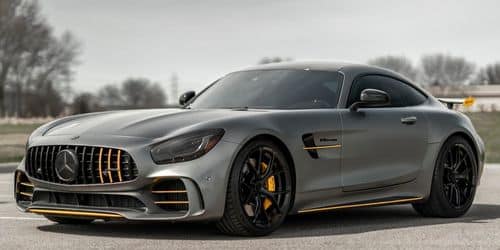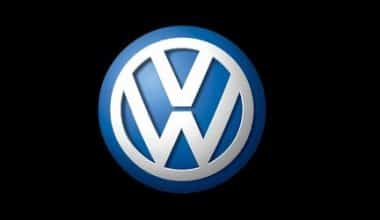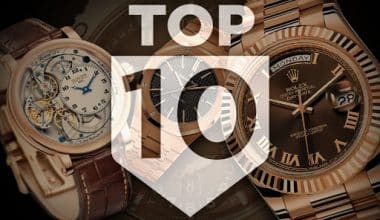Mercedes-Benz has a rich tradition dating back more than 130 years, and it has come to be associated with the concepts of quality, elegance, and innovation. Customers have relied on Mercedes-Benz automobiles to enrich their driving lives and to tastefully convey them to any location since Carl Benz developed the “Motorwagen” in 1886. Mercedes-Benz rose from humble origins to become one of the automobile industry’s largest titans. This is due to the Mercedes-Benz logo and brand focus on innovation, which is continually looking for new ways to better the lives of its customers. Mercedes-Benz is a popular name in the world of premium automobiles, but where does it come from? Let us explore this fascinating past.
The Great Founders of Mercedes-Benz
Gottlieb, Daimler:
Gottlieb Daimler was born at Schorndorf on March 17, 1834. From 1857 to 1859, he attends the Polytechnic School in Stuttgart after training as a gunsmith and working in France. In 1862, he begins work as a draftsman in Geislingen after finishing numerous technical activities in France and England. He is assigned workshop inspector in a machine tool business in Reutlingen at the end of 1863, where he meets Wilhelm Maybach in 1865. In 1872, he is appointed Technical Director of the Deutz Gasmotorenfabrik, where he becomes acquainted with Otto’s four-stroke technology. He departs the company in 1882 due to disagreements with the Managing Director.
Daimler establishes a development workshop in his greenhouse at his Cannstatt residence to focus on the development of petrol-powered four-stroke engines. In 1884, he collaborates with Wilhelm Maybach to create the ‘Grandfather Clock,’ an internal combustion engine. The machine’s compact, lightweight design makes it ideal for installation in a vehicle. However, the expenditures of experimental operations quickly deplete Daimler’s money, forcing him to seek business partners.
On November 28, 1890, he founded the ‘Daimler-Motoren-Gesellschaft’ with Max Duttenhofer and his business partner Wilhelm Lorenz. However, while Duttenhofer wishes to produce stationary engines, Daimler wishes to focus on vehicle production, resulting in a disagreement.
Read Also: EUROPEAN CAR BRANDS: Top 19+ Luxury European Car Brands in the USA
Daimler resorts to a hoax after Wilhelm Maybach resigns in 1891 owing to unfavorable contract terms. He still works with Maybach to produce engines, but all of the patents are in his name. Due to their deteriorating relationship with Duttenhofer and Lorenz, they have decided to eliminate Daimler as a shareholder. A decline in funding causes technical growth to stall, prompting DMG to attempt to reinstall Maybach in 1895. He refuses, stating that he would not return without Daimler.
Finally, commercial forces force both of them to return to the company. The Daimler engine is gaining popularity in other countries thanks to the Maybach Phoenix engine. A group of English businessmen is willing to pay 350,000 Marks for licensing rights. Maybach is appointed Technical Director of DMG, while Gottlieb Daimler is assigned to the Technical Board and becomes the Supervisory Board’s Inspector General. The return of both guys to DMG is a welcome surprise for the company. Gottlieb Daimler can only enjoy this quick development for a limited time. On March 6, 1900, he dies of heart illness.
Bertha and Carl Benz:
Carl Benz was born in 1844, and despite his family’s meager resources, his mother made certain that he attended grammar schools and subsequently went on to study mechanical engineering. He quickly rose through the ranks, from the locksmith to designer to workshop foreman, but his true passion had always been cars.
He co-founded his first company with mechanic August Ritter in 1871. However, Ritter soon departed the company, and Carl continued to work on a gas-driven two-stroke engine under the name Carl Benz and August Ritter, Engineering Workshop. This engine would enable Carl to realize his ambition of driving a vehicle without the use of horses.
Carl got this engine to run for the first time on New Year’s Eve 1879, making his ambition a little more attainable.
He went on to create a new company, Gasmotorenfabrik Mannheim, a few years later in October 1882. (Mannheim Gas Engine Factory). However, he would depart this company in less than a year since the other shareholders were more interested in the safer business of stationary gas engines than the unknown of motor engines.
Read Also: GERMAN CAR BRANDS: The Most Reliable Brands in 2022 (Updated)
Carl founded Benz & Cie in January 1883. Max Rose and Friedrich Wilhelm Esslinger of Rheinische Gasmotoren-Fabrik Mannheim. Carl introduced the two-stroke System Benz engine through this company. Benz, like his previous company, ran into creative differences with his new partners, who were skeptical of the automobile, and in May 1890 Julius Ganss and Friedrich von Fischer replaced the previous investors.
The dual business model of producing stationary and vehicle engines proved successful under this corporation, and the Benz brand developed, eventually becoming the second-largest engine manufacturer in Germany and the world’s top maker of automobiles by the end of the century.
The four-wheel motorized Velocipede, which was produced between 1894 and 1901 and is regarded as the first mass-produced automobile, was the company’s economic breakthrough. It was light, inexpensive, and had two seats.
Carl was delighted with the success of his company, but his vision for the future had always been the automobile, and he wanted to focus on building vehicle engines. Carl Benz Söhne, his final company, was founded in 1906 (Carl Benz & Sons). Despite passing management control to his sons six years later, he remained active in the firm and served on the board of Daimler-Benz AG until his death in 1929.
Bertha, Benz:
Bertha Benz is not as well-known as her husband, but she is perhaps just as vital to the success of his automobile company. She is one of the 20 most powerful women in the automotive business because, without her financial and emotional support, Benz & Cie would not have become the brand it is today or been part of the Daimler-Benz AG corporation, which is now one of the world’s major vehicle manufacturers.
Bertha married Carl in 1872 and spent her dowry and later fortune in her husband’s vehicle firms, giving him unreserved emotional and financial support in his efforts to create the automobile.
Carl Benz later acknowledged Bertha’s support for his pioneering spirit in his memoir, writing, “Only one person remained with me in the modest ship of life when it appeared destined to drown.” That woman was my wife. She boldly and bravely set the new sails of optimism.”
Bertha was the first person to drive a gasoline-powered automobile any significant distance, demonstrating its durability and capability in ordinary life. In 1888, she drove the 100 kilometers from Mannheim, where the Benz family lived, to Pforzheim to see her mother, taking the couple’s two adolescent boys Eugen and Richard with her. Bertha and her sons returned less than a week later, and word of her motorcar travel quickly spread, allowing her to achieve her goal of broadly advertising the Benz Patent Motor Car and its dependability.
Wilhelm Maybach: The Designer
Wilhelm Maybach, the son of a master joiner, is born on February 9, 1846, in Heilbronn. He orphaned at the age of ten when both parents died within three years of one other, is adopted into the Reutlinger Bruderhaus in 1856 after friends of the family make an announcement in the ‘Stuttgarter Anzeiger’ newspaper.
Wilhelm Maybach met Gottlieb Daimler for the first time in 1864 while working in the machine shop at the Bruderhaus. Their bond will last for the rest of their lives. Wilhelm Maybach first accompanies Daimler to Karlsruhe, then to the engine firm Deutz in 1872. In January 1873, he is appointed lead designer after a brief term as a draughtsman. When Gottlieb Daimler departs the Deutz Gasmotorenfabrik due to internal squabbles in October 1882, Wilhelm Maybach joins him in Cannstatt.
They work together to create a lightweight, high-speed combustion engine. Daimler and two business partners, Max Duttenhofer and Wilhelm Lorenz, establish the Daimler-Motoren-Gesellschaft (DMG) in November 1890. Although Wilhelm Maybach was in line to become head designer, he is dissatisfied with the contractual constraints and left DMG in February 1891. What follows is an extraordinary temporary solution. Maybach’s mobility concept is secretly funded by Daimler.
Working with a small team at the Hotel Hermann in Cannstatt, he creates major design innovations such as the belt drive, the Phoenix engine, and the spray nozzle carburetor, which influence the automobile industry for decades to come.
Also read: GERMAN CAR BRANDS: The Most Reliable Brands in 2022 (Updated)
In November 1895, Gottlieb Daimler and Wilhelm Maybach are reinstated at DMG at the request of English businessman Frederick Simms, who negotiates a significant license contract with the company. Maybach’s major goal is to restore DMG’s competitiveness through technological innovation and dependable goods.
Extensive development work is being carried out in order to get the concepts developed in the Hotel Hermann to series production status. The most noteworthy result is the belt-driven car, the first automobile built in significant quantities by DMG. Maybach’s reputation within the firm rapidly deteriorates following the death of Max von Duttenhofer in August 1903, eventually culminating in his departure from DMG in April 1907.
Disgusted by his treatment, Maybach starts a business with his sons, producing the now-legendary vehicles carrying his name. Wilhelm Maybach, 83, dies on December 29, 1929, in Cannstatt.
This is also where the automotive pioneer is buried, near Gottlieb Daimler’s grave in the Uff-Kirchhof cemetery.
Emil Jellinek:
Emil Jellinek, while less well-known than the other three persons involved in the development of Mercedes-Benz, is equally responsible for the brand’s name and how well-known it is now.
He was born in 1853 and dropped out of school as soon as he could. He subsequently worked in the training industry for a few years before becoming a successful merchant in North Africa for several years. His skills as a salesman would come in handy later in his career in the automotive sector.
Emil returned to Europe with his wife and young children in 1889, first to Vienna and then to Nice, where he bought his first car, a De Dion-Bouton tricycle. This was quickly followed by a three-wheel Léon-Bollée Voiturette and a four-seater Benz carriage by Carl Benz.
Emil visited the Daimler factory in Cannstatt in 1897 and ordered his first Daimler car, a 6 hp belt-driven model with a two-cylinder engine. The highest speed of 24 kilometers per hour soon became too sluggish for Emil, and he requested a top speed of 40 kilometers per hour, which he received less than a year later in September 1898 in two Phoenix vehicles from Daimler.
Emil also began to seriously deal with cars, specifically Daimler models, in 1898, using his relationships in the international finance sector and aristocracy that he had developed through his years as a trader.
As he marketed and sold Daimler models to the upper classes, he began to request from DMG increasingly powerful and fast automobiles, which he would not only sell but also race. Mercedes was a name recognized in automobile circles in the late 1890s due to his racing skill under the guise of his daughter’s first name Mercedes.
Read Also: KOREAN CAR BRANDS: Best 19+ North & South Korean Car Brands in USA
Mercedes did not become a product name until April 1900, when Emil and DMG reached an agreement covering his sale of automobiles and engines, as well as agreeing to build a new type of engine under the name Daimler-Mercedes.
Wilhelm Maybach designed the first Daimler-Mercedes automobile, which was delivered to Emil in December 1900. Because of its low center of gravity, pressed steel frame, and lightweight yet powerful engine, it sparked interest in his circle. This car is often regarded as the first modern automobile.
Emil continued to race Mercedes, and the Mercedes racing models were virtually unbeaten throughout the 1901 Nice Week, making them even more appealing to drivers at the time.
Mercedes was registered as a brand name and became legally protected in 1902.
Emil began working for the Monaco consulate in 1907, and two years later he ceased dealing with vehicles to focus on his position at the embassy. Nonetheless, he maintained a great interest in automobile technical innovations until his death in 1918.
The Mercedes name persists today due to Emil, and we don’t refer to Daimler-Benz cars by other names. His involvement in racing and selling cars further contributed to the brand’s popularity throughout Europe.
The Merger of Daimler-Benz AG
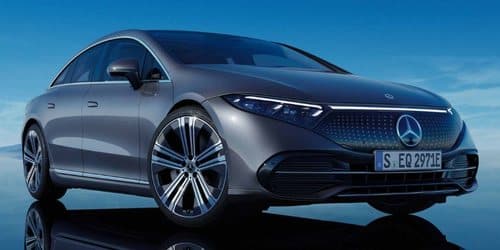
You may have noticed that we’ve discussed Daimler and Mercedes separately thus far, which is because they were competitors until the 1920s. However, following World War One and its impact on the automotive industry, DMG and Benz & Cie merged to form Mercedes-Benz Automobil GmbH, allowing them to remain competitive in the larger market by coordinating designs, production techniques, purchasing, sales, and advertising.
With the founding of Daimler-Benz AG in 1926, they formally became one firm, and the Mercedes-Benz vehicles were publicly presented as early as October 1926 at the Berlin Motor Show.
Which is better compared: BMW or Mercedes?
However, if you have the funds to purchase a BMW or Mercedes, it’s difficult to go wrong with any model in their current lineup. However, as a general guideline, if you want something sportier, stick with BMW, and if you want something upscale and elegant, Mercedes-Benz may be a better fit.
What is Mercedes’ complete title?
Mercedes-Benz is derived from Mercedes Jellinek and Karl Benz. Mercedes-Benz was originally formed by Karl Benz and Gottlieb Wilhelm Daimler as part of Daimler Motoren Gesellschaft, or DMG.
What is the accurate cost of a Mercedes-Benz?
Mercedes-Benz automobiles in India are priced at a minimum of 42.00 Lakh for the A-Class Limousine and a maximum of 3.20 Cr for the Maybach S-Class. The AMG E 53 Cabriolet, with a price tag of 1.30 Cr, is the newest Mercedes-Benz vehicle.
The Beginnings of “Mercedes”
The term “Mercedes” originally appeared in 1901, shortly after Gottlieb Daimler’s death. Emil Jellinek, a German-born racing enthusiast, and entrepreneur were instrumental in marketing the “horseless” Daimler autos to the upper crust.
In 1899, Jellinek competed in a race in Nice, France as “Monsieur Mercedes,” after the name of his daughter, Mércedès, whose Spanish Christian name translates to “mercy.” Not long after (in 1901), DMG trademarked the name “Mercedes,” and Jellinek began marketing the new vehicle abroad to such high-profile families as the Rockefellers, Astors, and Morgans.
Mercedes Benz Logo History:
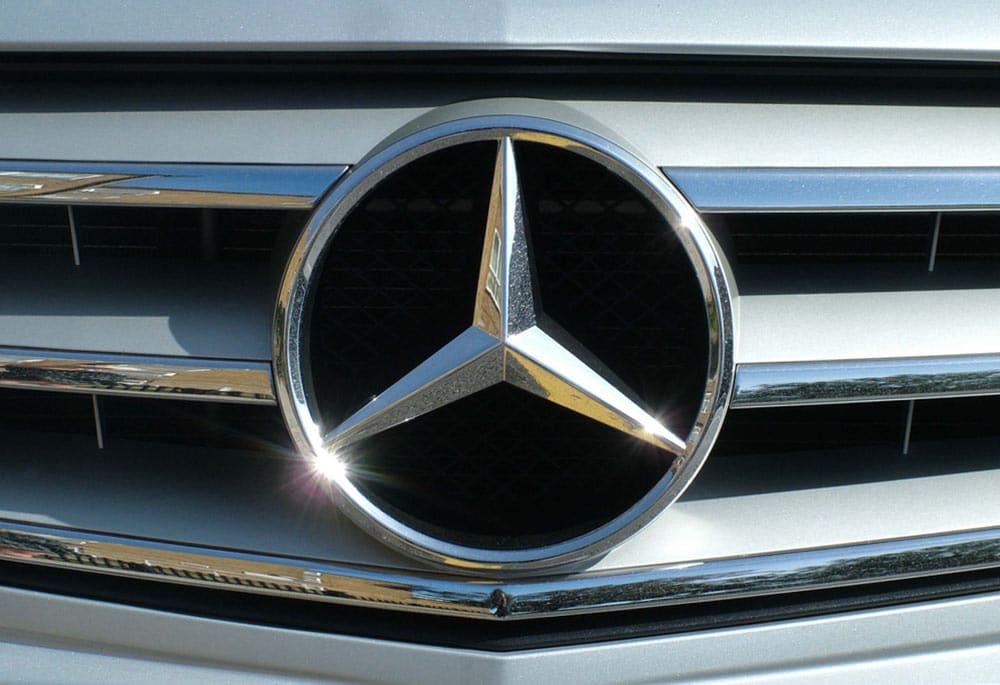
Simple but effective, it’s difficult to find anyone today who isn’t familiar with the Mercedes-Benz logo.
The form, best known as the “Mercedes star,” has remained a consistent aspect of the Mercedes emblem for some years, despite the fact that the Mercedes Benz logo initially had simply the corporate name and nothing else.
Today’s “new” Mercedes benz logo is a basic three-point star in gleaming metallic chrome.
According to Gottlieb Daimler, one of the founders, the star meant protection and eventually took on the meaning of “perfection” as the number “3” became acknowledged as sacred, integrating the elements of water, air, and land.
In some cases, the Mercedes logo appears alongside the name “Mercedes Benz,” which is normally written in a basic serif font with a sentence case structure.
Which is costly car BMW or Mercedes?
Depending on the model, Mercedes and BMW cost between $40,000 and $150,000. However, it appears that Mercedes is more expensive than BMW. Perhaps this is due to the country’s technological advances. Therefore, if you have a limited budget, you may want to select the BMW luxury brand.
Mercedes Benz: Logo Brand Overview
| Founded: | 1926 |
| Founder: | Karl Benz and Gottlieb Daimler |
| Headquarters: | Stuttgart, Germany |
| Website: | www.mercedes-benz.com |
| Logo downloads: | PNG Vector |
The original Mercedes logo was designed by Gottlieb’s sons, Adolf and Paul. Initially, the design was a gold star inspired by a symbol used by their father to designate family postcards.
The logo was eventually changed to a white star in the center of a circle. The image is now a silver circle with a three-pointed star in the center.
Though the logo retains meaning for the family, it also signifies the power of Daimler engines on land, sea, and air.
Mercedes Benz Logo Evolution: Mercedes logos through the years
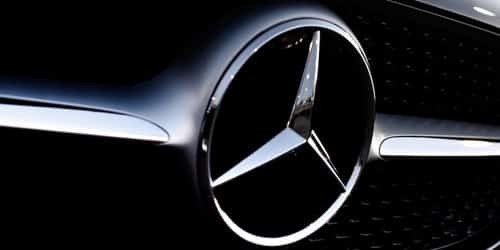
As previously stated, the old Mercedes logo did not have the star picture at all, but this was swiftly modified with the Daimler family’s participation.
Let’s take a look at how the Mercedes benz logo has evolved over time…
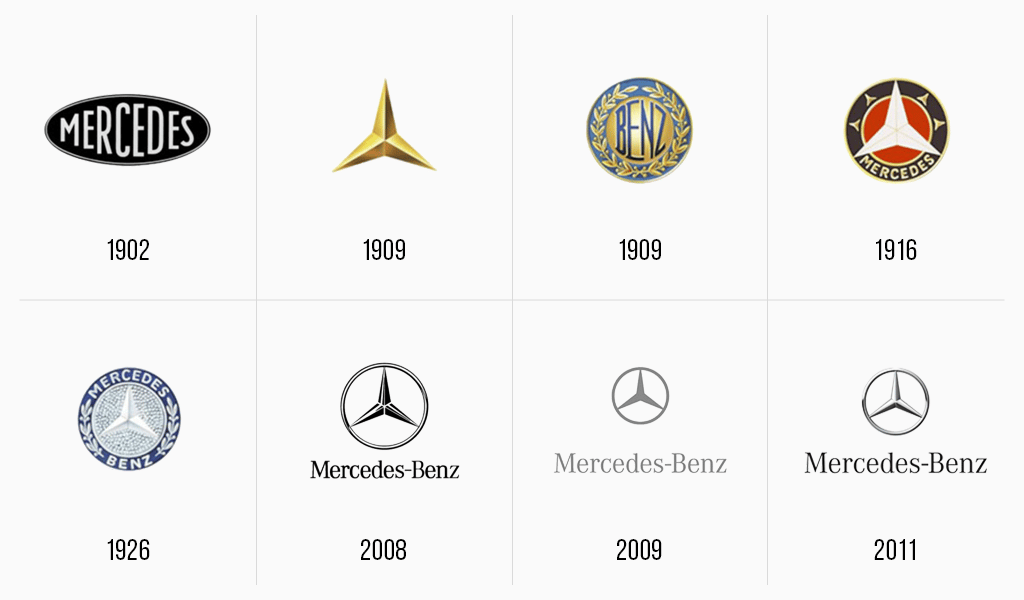
1902
The original Mercedes insignia was an oval badge positioned horizontally with a sans-serif wordmark in the center. The Mercedes insignia was remarkable in that the core letters of “Mercedes” were larger than the surrounding characters.
This logo’s letters were all capitals and designed in a mellow grey.
The oval itself was black, with a grey and black double outline to bring attention to the name in the center.
1909
In 1909, the design of the Mercedes vehicle insignia underwent considerable changes. This time, the business released a circular insignia in the middle with the word “Benz” in the capital, serif letters.
The word was written in black on a grey circle, surrounded by a black border. The black border included a wreath in the shape of a crest.
This design was significantly more traditional and intricate than the previous one, and it was supposed to convey the brand’s luxurious energy.
1916
The distinctive Mercedes three-point star first appeared in 1916, with much more color for the image. The gold and white star was designed on a red background with a thick circular frame.
This logo still had a lot of intricate embellishments, but it was a little simpler than the elaborate emblem formerly used by the corporation.
1926
In 1926, a more monochromatic version of the badge was produced, with a 3D design of the three-pointed star in the middle of the insignia. The previous wreath-style design’s laurel leaves were used in this rendition of the image.
1933
By 1933, Mercedes had begun to streamline their logo, maybe to make it easier to transfer across different mediums. The Mercedes logo quickly evolved into a simple, minimalistic rendition of the three-pointed star within a circular symbol.
Mercedes Benz Logo 1989
1989
Mercedes redesigned their star for the modern market again in 1989, making it three-dimensional and changing the color palette to grey gradients supposed to represent chrome or silver.
The glossy metallic quality of the symbol precisely matched the visual found on a car’s badge anywhere in the world.
The tidy and stylish text “Mercedes-Benz” beneath the insignia included a serif typeface with simple, narrow characters, ideal for displaying refinement.
2009
This graphic was slightly modified in 2009, with greater weight given to the star in the circle, giving it the appearance of a steering wheel on a sport or racing automobile.
The Mercedes-Benz logo introduced in 2011 evolved into the official picture we know today, with a somewhat softer grey tone and a slightly deeper weight to the wordmark.
Mercedes Benz Logo Interpretation
For the firm, the Mercedes insignia has several meanings. As a tribute to the Daimler family, the distinctive three-pointed star became the brand’s image in the 1920s. Daimler’s two sons chose the star to reflect the mark their father used to put on family correspondence.
The traditional contours of the classic five-pointed star were slightly altered to represent the three areas in which Daimler excelled: vehicles for the air, sea, and sky.
Originally, the symbol was only the company’s name, as are many of the other competing automobile brands present throughout the world today.
Because many people equate the number three with ideals of excellence, the three points of the star are frequently believed to signify “perfection.” The circle that encircles the three-pointed star denotes both community and worldwide accomplishment.
Mercedes Logo Colors
Throughout the first few decades, Mercedes modified its logo and logo color several times. Initially, the star insignia was colored white, gold, red, black, and grey.
The business experimented with several variants of the star over the years, including simple monochromatic alternatives. The most well-known variation of the Mercedes insignia today is made of basic textured silver that is designed to resemble chromium.
The Mercedes logo’s colors are:
- Deep blue – HEX color: #0B1F2A
- Elephant blue – HEX color: #27343C
- Greyish blue – HEX color: #333F47
- Fiord grey – HEX color: #565F64
- Aluminium grey – HEX color: #828A8F
- Mercedes grey – HEX color: #A4AAAE
- White – HEX color: #FFFFFF
- Black – HEX color: #000000
What is the Font used in the Mercedes logo?
The Mercedes logo typeface has changed several times throughout the years, beginning with an unusual type in the early years, in which the letters were larger towards the center of the word. Mercedes now use the Mercedes-Benz Corpo unique typeface.
To reflect thoughts of sophistication, heritage, and elegance, the typeface is a simple and effective serif.
The Mercedes logo is being honored.
The Mercedes logo is currently one of the most well-known images in the vehicle environment, famous among car enthusiasts all over the world. Whether you like Mercedes cars or not, you’re definitely familiar with the company’s logo.
Including the “Benz”
Until this moment, DMG’s trademark automobile was “Mercedes.” DMG amalgamated with Benz & Cie to become “Daimler-Benz” in 1926, and the name “Benz” was formally applied to the Mercedes model. Daimler improved the three-pointed star emblem in 1937 to be a “three-dimensional, three-pointed star encased in a circle,” which is still used today.
Following the sale of Chrysler, with whom the firm had merged in 1998, Daimler-Benz became “Daimler AG” in 2007. Mercedes-Benz would no longer be a trademark of Daimler AG, but rather its own subsidiary, Mercedes-Benz AG, in 2019.
Mercedes-Benz Car Evolution:
Mercedes has developed so many excellent models over the years that we could spend days going through them all, but instead, we’ve chosen select models that we believe was critical to Mercedes’ evolution and helped drive the car industry ahead as a whole.
#1. Benz Patent Motor Car:
In January 1886, Carl Benz applied for a patent for a three-wheeled vehicle powered by his gas engine, which was the first patent for a vehicle powered by an internal combustion engine with electric ignition.
Carl addressed the vehicle’s development with an integrated design, with the engine, chassis, and drive components all linked to making a single unit. This was an approach that none of his competitors were using at the time, and his engine weighed roughly 100 kilograms, making it a relatively light model for its day. This vehicle’s internal combustion engine is extremely similar to those found in our automobiles today, with the same key features such as a crankshaft with counterweights, electric ignition, and water cooling.
This model was rear-wheel drive, with engine power going to the back wheels and steering handled by a single front wheel turned by a toothed rack and crank. The early editions lacked a multispeed transmission, a footbrake, and reversing capabilities, however, these would be added soon. Instead, a sleeve valve under the driver’s seat controlled the speed, while a hand leaver controlled the brake.
On July 3, 1886, the Benz patent motor automobile had its maiden public drive, and history was created. This car is widely regarded as the world’s first motor vehicle.
#2. Velocipede Benz Motor:
The Velocipede was Benz & Cie’s first mass-production car. The vehicle industry was transformed by a four-wheel motorized two-seater.
This model was manufactured between 1894 and 1901, with approximately 1,200 units sold.
Its lightweight design and inexpensive pricing contributed to the model’s success in Germany and around the world.
#3. S Class:
The Mercedes Simplex, a new top-of-the-line vehicle that was also available in the more elegant touring saloon form and provided drivers with an astounding 60-horsepower engine, was developed by Wilhelm Maybach in 1903. With its sense of elegance and high-quality finish, the Simplex 60 hp was essential in making the motor automobile an acceptable mode of travel for the upper classes, making the Mercedes name synonymous with luxury, which remains to this day.
The S Class is still available in saloon, cabriolet, coupe, and the top-of-the-line Maybach model today.
#4. Silver Arrows:
When the W 25 won the Eifel race in 1934, Mercedes ushered forth a new era of motor racing success. This was the first of many Silver Arrow victories, which continue to this day.
The new W 25 weighed a kilogram over the race regulations’ allowance of 750 at the weighing station the night before the Eifel race. Manager Alfred Neubauer had the white paint ground off the car to reduce its weight, and the next day it was light enough to race. With the paint removed, the aluminum body was revealed, which had a silvery color that gleamed in the sun.
Manfred von Brauchitsch, the driver, later told the press that “driving a Silver Arrow is an honor,” and thus a legend was born. Even as recently as 2012, when Nico Rosberg won the Chinese Grand Prix, the Silver Arrow race cars remained front runners on the racing circuit.
#5. 260 D Mercedes-Benz:
The Mercedes-Benz 260 D was part of the popular W 138 Series, which debuted in 1936.
This was the world’s first series-production diesel passenger car, and it genuinely revolutionized the automobile industry by demonstrating how diesel might be a viable alternative to the market’s dominant petrol engines. The car had an excellent 9.5 liters average diesel fuel usage, which meant that a full tank could last you 400 kilometers, up to 500 kilometers when the model was revised a year later. This was a great perk for drivers at the time because gas stations were less common on the road than they are now.
Later that year, Mercedes-Benz released Pullman saloon and Convertible B body variants of the 260 D models, making diesel even more accessible to private drivers.
The 260 D’s stylish and comfortable design, combined with the diesel engine’s fuel economy and power, was critical in helping the general public see diesel as an alternative to gasoline as early as the 1930s.
#6. SL Mercedes-Benz:
The Mercedes-Benz SL has become a sports car legend.
It was first manufactured in 1952 and was intended to be a racing sports car with high performance due to its aerodynamic design, powerful engine, and distinct sense of style. Mercedes-Benz would go on to build a series of vehicles under the SL moniker that refined the athleticism that the original SL signified, but married it with features aimed at comfort and safety for drivers off the track, which continued to set the standard.
#7. Pullman 600:
The 600 Pullman was a limousine that was manufactured from the mid-1960s through 1981.
A four-door car with two additional rear-facing seats separated from the driver compartment by a window was available, as was a six-door car with two forward-facing seats at the middle doors and a back bench-style seat.
For nearly 20 years, this model was thought to be the last of Mercedes’ premium limousine style cars, until the Maybach brand was revived with the 57 and 62 models in the late 1990s. These cars were short-lived, but the 600 Pullman’s aura of richness and refinement continues on in the Mercedes-Maybach S Class Saloon.
#8. E Class:
The E Class is a favorite of ours at Car Lease Special Offers. It’s one of our top five coupes, estates, saloons, and convertibles, and it also comes in all-terrain variants.
The first E Class was introduced in 1984 with the 124 Series, but it wasn’t until 1993, when Mercedes introduced a new nomenclature scheme, that the automobile was officially dubbed an E Class. The 124 series was an intermediate-class saloon, a mid-sized automobile that sat between the smaller C Class and the larger S Class, with a variety of petrol and diesel engines and body designs to select from.
There were parallels between the E Class and the more compact C Class, just as there are today, with similar building materials used, design overlap, and the latest engine technology and safety features used.
#9. C Class:
The C Class, like the E Class, debuted under a different name in 1982 until Mercedes revised their naming process in 1993 when the C Class got its new name. The compact saloon was previously known as the W 201.
The 201, and later the C Class, were ideal for families looking for a smaller and cheaper model than the mid-range E Class but unwilling to compromise on performance, safety, or passenger comfort.
The C Class is still one of Mercedes’ best-selling models and is now available in saloon, estate, coupe, and cabriolet body styles.
#10. EQC:
The EQC was first introduced in 2019 and was Mercedes’ first fully-electric vehicle, though more are on the way.
As governments around the world seek to reduce emissions and remove fossil fuel-powered internal combustion engine vehicles from our roads, the automobile industry as a whole is shifting toward electric and other greener vehicles. New petrol, diesel, and hybrid car sales in the United Kingdom will be prohibited beginning in 2035.
The transition to greener mobility is transforming the automobile industry, and with the unveiling of the EQC SUV, Mercedes demonstrated once again that it is at the forefront of creative technological developments, just as it was over a century ago.
Although we have just looked at cars, Mercedes also manufactures and sells motorcycles, vans, trucks, and buses worldwide.
#11. Racing:
Daimler-Benz AG, like many other manufacturers in the early 1900s, used racing to promote its brand and gain global recognition.
Benz & Cie and DMG had used the emerging motor racing sport to boost awareness of their vehicles even before the brand was founded. Indeed, Emil Jellinek’s racing performance was essential in negotiating his contract with DMG, and the Mercedes’s name became synonymous with powerful and quick engines, which the brand is still known for today.
Mercedes has achieved numerous racing accolades and had world-renowned drivers on their teams over the years, from Rudolf Caracciola, who in 1938 reached 268.9 mph on the Frankfurt-Darmstadt autobahn, a record he still holds to this day for speed on a public road, to Lewis Hamilton, the youngest Formula One world champion, and Michael Schumacher, the most successful Formula One driver of all time.
Other notable Mercedes drivers include Hermann Long, Juan Manuel Fangio, Klaus Ludwig, and Jenson Button, to name a few.
Today’s Mercedes-Benz:
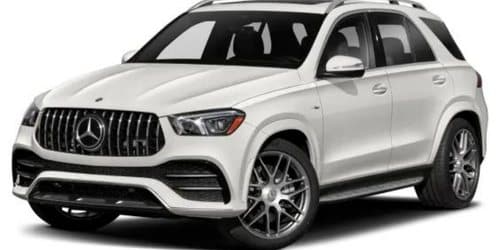
Although this post focuses on Mercedes from the past, we can’t ignore how these models influenced the Mercedes we drive today and the advancements the company is making in the automotive industry.
Without Carl Benz and Gottlieb Daimler’s ambitions for the automobile and their devotion to seeing them realized, the automobiles we drive today would look substantially different. Their legacy is a car manufacturer whose name is known around the world and recognized as a brand that produces automobiles made of high-quality materials, with powerful engines that use the most cutting-edge technological innovations.
Today, the corporation has facilities and dealerships all over the world, and it imports and exports to almost every country. They not only manufacture vehicles but also collaborate with governments and other businesses on a national and local level to benefit the communities that support their operations, such as through their sponsorship of the sports charity Laureus.
